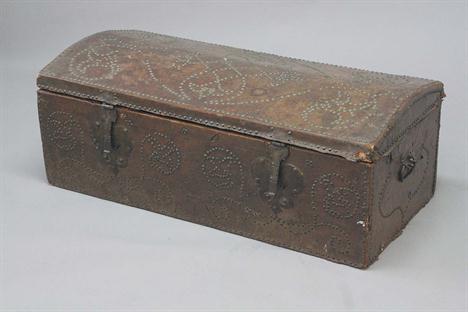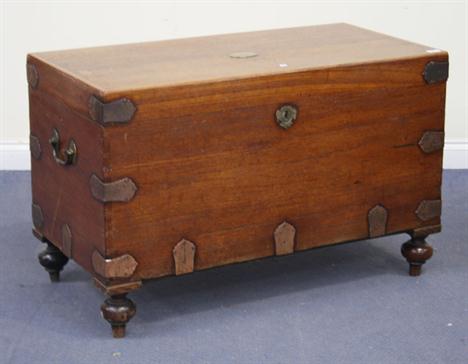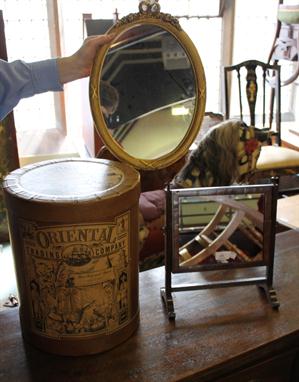We found 66887 price guide item(s) matching your search
There are 66887 lots that match your search criteria. Subscribe now to get instant access to the full price guide service.
Click here to subscribe- List
- Grid
-
66887 item(s)/page
Mahogany inlaid long case clock, early 19th century, the painted broken arch face with maritime rolling moon and personified continents at the spandrels, Arabic hours, centre sweep date and seconds, Bucknall Burselm , eight day movement on a false plate, striking the quarter on two bells, in a swan neck hood with fluted columns on broad trunk and short door, flanked by fluted columns on broad base and ogee bracket feet, height 226cm. (pendulum).
Mahogany long case clock, early 19th century, painted broken arch dial with rolling moon, subsidiary seconds and date aperture, eight day movement on Walker false plate, rack strike, anchor escapement in a swan neck hood with turned side columns on a broad trunk and set out base with canted corners and ogee bracket feet, height 224cm (pendulum, two weights, winding key).
A George III oak thirty hour longcase clock, the 12 inch square painted dial indistinctly signed and with later hands, the hood with dentil moulded cornice over a square glazed hood door flanked by turned front corner hood pilasters over a crossbanded trunk door on a box base and later skirting plinth, 209cm high (at fault)
An early 19th century mahogany eight day longcase clock the 12 inch arched painted dial signed 'James Robertson, Dundee' to the arch over an inner ring of Roman numerals and outer ring of Arabic numerals centred by subsidiary seconds and date dials, the hood with swan neck pediment over an arched glazed hood door between reeded turned front corner hood pilasters over an ogee arched trunk door between quarter turned reeded front corner pilasters on a plain box base and ogee shaped bracket feet, 207cm high
A George III mahogany eight day longcase clock the 14 inch arched brass dial signed `Hadwen, Ormskirk`, with centred subsidiary seconds dial and date aperture within an inner ring of Roman numerals, outer ring of Arabic numerals and classical urn moulded corner spandrels under a rolling moon to the arch, the arched hood with brass finials over fluted tapering front corner hood pilasters above a long crossbanded trunk door between fluted corner pilasters on a single panel box base and ogee moulded bracket feet, 227cm high, WE DO NOT STATE CONDTION IN THE ABOVE DESCRIPTION – Before bidding please ensure you are satisfied with the condition of this lot – For details of condition please contact the auctioneer.
A pair of gilt bronze two handled vases, late 19th/early 20th century, in Chinese archaic style, each of square section cast with an all over floral design below a scroll border, elephant trunk handles, the bases cast with a dragon and raised seal, 30cm high WE DO NOT STATE CONDTION IN THE ABOVE DESCRIPTION – Before bidding please ensure you are satisfied with the condition of this lot – For details of condition please contact the auctioneer.
A trunk labelled Miss Van Wart owned by Joan Van Wart 1900-1987 when she was touring with the Pavlova Company. Containing a large quantity of original photographs, some signed, relating to Anna Pavlova, the Company, Joan Van Wart and others, contracts relating to tours and a Pavlova Co identification card. A shooting script of the silent film The Immortal Swan with hand written notes and directions and an album with Pavlova and Novikoff in The Fawn. Pavlova and Karavaieff in Russian Dances. His Masters Voice record Homage to Pavlova, photographs and letters relating to the 1956 commemoration at the V & A. Many programmes including 1912 Russian Ballet Royal Opera Covent Garden. Van Wart hero worshipped Pavlova (1881-1931) and kept her very worn pink ballet shoes with a note. The archive was passed to Van Wart`s niece Sarah Fabian Jackson. For a fuller list of contents contact the department. The following 12 lots are from the estate of Joan Van Wart and her niece
Thomas Sherwood Snr, Yarm, an oak and mahogany longcase clock with an eight-day duration movement striking the hours on a bell, the 12½ inch painted arched dial with black Roman numerals, a subsidiary seconds dial, decorative brass hands and painted with scenes to the four corners depicting ruined buildings with a further scene to the arch depicting fishermen and boats within a riverscape, the centre painted with the maker`s name `T. Sherwood Snr, Yarm`, the falseplate to the dial embossed with the dialmaker`s name `Finnemore, B/Ham`, the oak case with mahogany crossbanding to the trunk door and base with mahogany quarter columns to the trunk and standing on bracket feet, the hood having mahogany quarter columns with brass capitals and a shallow swan neck pediment, height: 220cm. * Thomas Sherwood Snr is recorded as working in Front Street, Yarm, Yorkshire from 1771, the year of his marriage, having being apprenticed to the clockmaker Robert Burgrave of Doncaster. He married Mary Bushley with whom he had twelve children and following her death in 1798 he married Ann Melbury with whom he had a further two children including Thomas Jnr. Thomas Sherwood Snr died in 1821 whereupon Thomas Jnr continued the business having been apprenticed to the well-known maker William Pridgin of York in 1794. In 1807 Thomas Jnr married Eleanor, who then died giving birth and immediately married Jane Chapman with whom he had eight children, one of whom Thomas, became the third clockmaker in the family of that name taking on the business in 1836 after the death of his father. * George Walker & William Finnemore starting working life in a partnership with George Walker and were two of the most influential dialmakers in Birmingham in the first part of the 19th century. They are first recorded working in 1808 at Edmund Street although they were probably together for a few years before this date. The partnership split up in 1811 after which Finnemore went out on his own and started a dialmaking concern that stretched on for a number of years beyond his death, being run by firstly his wife and then his sons.
James Blackborow, London an ebonised and japanned longcase clock with the eight-day duration movement having turned finned pillars and striking the hours on a bell, the twelve-inch arched brass dial with a raised silvered chapter ring engraved with black Roman numerals, outer Arabic five minute numerals, fleur-de-lys half-hour markings and `meeting arrow head` half-quarter markings, the matted centre with ringed winding holes, subsidiary seconds dial, date aperture, cast brass female-head spandrels to the four corners, decorative blued steel hands and engraved to a silvered boss within the arch `Jams. Blackborow, London`, with a `strike/silent` lever to the base of the arch and wheat-ear border engraving to the top, the ebonised case now with raised chinioserie decoration to the trunk door only, having three-quarter columns with brass capitals to the caddy-top hood, a lenticle glass to the trunk door and with a plain base, height: 220cm. * James Blackbarow is recorded as working in London in the early 18th century having been apprenticed in July 1701 to the well-known Hugenot maker David Lesturgeon and made a Freeman of the Clockmakers Company in February 1711. He was made a Liveryman and then died in 1746 whilst in the position of Warder within the Company
A 19TH CENTURY EIGHT-DAY OAK LONG CASE CLOCK by Blaylock of Longtown, having a broken swan-neck pediment with petal carved detail and floral disk terminals over a strap-work frieze, the arched, glazed hood door with geometric carving between fluted columns, the long trunk door profusely carved with foliate scrolls, fruit filled urns and stylised sea creatures between fluted quarter columns and scroll carved sides, raised on a canted, carved rectangular base with short bracket feet. The arch of the dial having an applied silvered disk engraved with the maker’s name between applied gilt metal ornaments, the silvered chapter ring with Roman hours and Arabic minutes enclosing a subsidiary seconds dial, dates aperture, 2 winding holes and engraved decoration, all within applied gilt metal scrolling spandrels, sold with a pendulum and two weights, also a receipt for total overhaul carried out by Charles Kemp 3/12/2002. 227cm(h)
A VICTORIAN OAK AND MAHOGANY 30-HOUR LONG CASE CLOCK having a broken swan-neck pediment with ball finial, an arched glazed hood door and turned columns, the short, shaped and crossbanded trunk door between canted and fluted corners, raised on a plain base, the arch of the dial painted with a shepherd in a rural landscape, the chapter ring with Roman hours enclosing the indistinct maker’s name and town (possibly Penrith) and subsidiary seconds dial, all framed by painted floral spandrels. 218cm(h)
A LATE 18TH CENTURY OAK AND MAHOGANY 30-HOUR LONG CASE CLOCK by John Rawson of Penrith, having a moulded flat-topped hood with square glazed hood door between turned columns with brass capitals, the long shaped and crossbanded trunk door between canted corners, raised on a crossbanded base with conforming corners, on short shaped bracket feet, the painted dial with Arabic hours and quadrants framing the maker’s name and crescent form date aperture, all enclosed by painted fan design spandrels. 206cm(h)
(Lot of 2) Chinese Yixing ceramic tea pots, the first of compressed globular form with a tree trunk-patterned exterior accented with leafy sprigs and a branch form handle, the base marked `Zhang Chengxiu zhi`, the lid with a lingzhi form finial; the second of compressed ovoid shape with a fluted exterior, applied with a loop handle opposed by a shaped spout, the recessed base marked `Gu Jingzhou`, the lid decorated en suite, overall: 7.5"w Start Price $150
A Victorian oak longcase clock, the shaped pediment mounted with brass gold rosettes flanking an eagle finial, having an egg-and-dart moulded cornice above an arched door, with movement by James Potts of Berwick, the enamelled dial with floral spandrels above a trunk with fluted columns, and a base with further egg-and-dart carvings. (88in),400,600
-
66887 item(s)/page















































